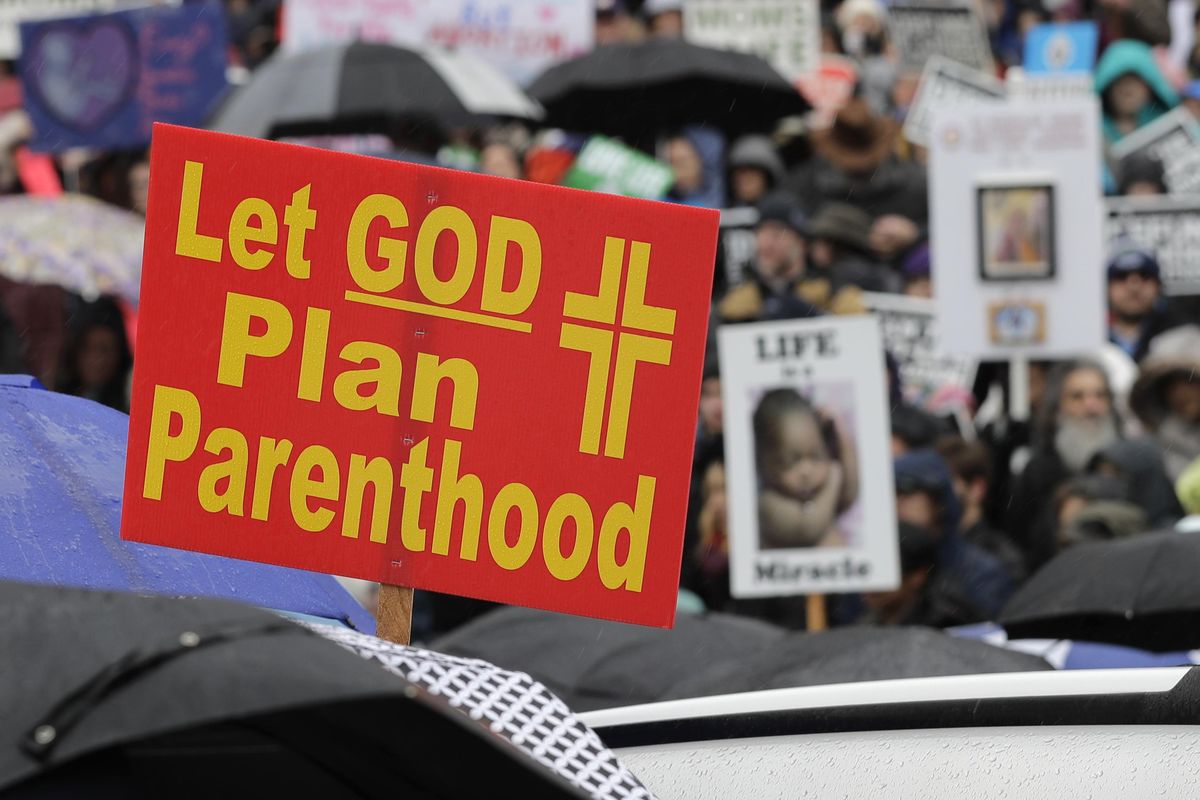The March for Life says it’s ‘pro-science,’ despite medical consensus favoring abortion access
A sign reads “Let GOD Plan Parenthood,” during an anti-abortion march and rally, Tuesday, Jan. 22, 2019, at the Capitol in Olympia, Wash. The event was part of annual “March for Life” events held in other states and Washington, D.C., near the Jan. 22, 1973 anniversary of the Supreme Court’s Roe v. Wade decision, which legalized abortion. (Ted S. Warren / Associated Press)
WASHINGTON – Thousands of protesters will gather on the National Mall Friday for the March for Life, the largest annual anti-abortion demonstration. The protest’s theme this year claims that opposition to abortion is “pro-science” – a branding attempt that underscores the shifting make-up and attitude of the anti-abortion movement, but one that the medical community broadly opposes.
“Science is behind the pro-life movement. We see that medical and technological advancements always affirm the pro-life movement,” March for Life president Jeanne Mancini said when she announced this year’s theme.
But the largest medical organizations that treat pregnant women and their babies disagree, very vocally supporting access to abortion. The gulf between two camps, both claiming the mantle of science, leads straight to the questions at the heart of the abortion debate – questions of when life begins and how to define it, and how to weigh the needs and rights of women in a variety of ethically challenging circumstances.
The throngs who will flock to the Mall on Friday for an 11 a.m. rally, followed by a 1 p.m. march to the Supreme Court, will shout their belief, in the form of chants and banners and posters, that a unique human life begins at the moment an embryo is conceived.
Since the March for Life began in 1974, the year after the Roe v. Wade decision legalized abortion nationwide, that crowd has been largely youthful, including Catholic school students who ride buses from all over the country to attend the march. In recent years, the march has tried to welcome a broader group of people who oppose abortion. In addition to the march’s Catholic core, an Evangelicals for Life conference now draws a sizable contingent. Other groups march in step, like Secular Pro-Life and Democrats for Life of America.
“We tell students, ‘Hey, if you’re a Democrat or a liberal or atheist – whatever you are – you can be pro-life,’” said Kristan Hawkins, the president of Students for Life of America, which brings college chapters from across the country to the march.
In this shifting environment, the march leaders’ choice to focus on science this year – under the theme, “Unique from Day One: Pro-Life is Pro-Science” – invites participants to make arguments beyond the religious and the political in favor of restricting access to abortion.
“When I speak about abortion, I don’t talk in terms of religion. I might make a spiritual appeal at the end,” said Ben Shapiro, the popular conservative writer and podcast host who will be a featured speaker at Friday’s rally. “I always speak in terms of logic and science. I’ve never cited the Bible.”
Shapiro is an Orthodox Jew – not the typical religious background of an anti-abortion activist – and he insists that there’s no science on the side of those who advocate for abortion rights. “I don’t think they make scientific arguments. I think they make emotional appeals,” he said. “I don’t think there are very good scientific arguments on the other side, which is one of the reasons I’m not pro-choice. The basic scientific definition of human life begins at conception. That is the most basic scientific definition of human life.”
That’s the argument made in the two scientific papers that the March for Life advertised along with its announcement of its “pro-science” theme. One, published by the anti-abortion nonprofit the Charlotte Lozier Institute, describes the meeting of a sperm cell and an egg cell to form a zygote, a new type of cell distinct from the two that formed it. The paper then asks whether that cell is its own organism separate from the mother, or a part of a human like a liver cell or a skin cell.
The fact that the zygote “directs its own development,” leading it to eventually turn into more complete embryo and eventually a baby in the right circumstances, leads the writer of the paper (a neurobiology and pediatrics professor at the University of Utah) to conclude that from the moment of conception, embryos “are indeed living individuals of the human species.”
Sarah Horvath, a doctor who has performed abortions and currently works as a family planning policy and advocacy fellow for the American College of Obstetricians and Gynecologists, said that ACOG, a 58,000-member organization that includes more than 90 percent of the ob/gyns in the United States, disagrees with that scientist’s explanation of life.
“I think that’s a gross exaggeration of an incredibly complex topic. There are many fertilized eggs that never implant, that implant in the wrong place… that become miscarriages, that in fact can become a type of cancer,” Horvath said.
She said that medical professionals don’t have a working definition of when life begins. ACOG does strongly support increased access to abortion in its official positions. “Science isn’t really designed to answer questions about the exact beginning of life or the moral assignations of these sorts of things. Science is really more designed to teach us how things work, and then we can allow people to make their own decisions about what that means for them,” she said. “Science tells us that abortion is safe. Science tells us that abortion is health care. Science tells us that abortion care can be lifesaving.”
That’s the first disagreement. The second disagreement: Putting aside when life begins, what should women be allowed to do about an unwanted pregnancy? One can believe that an embryo is a life or not a life, and still have differing opinions about whether a woman should be able to choose to end her pregnancy.
The second paper promoted by the March for Life stakes out a clear opinion: “The College values all human lives equally from the moment of conception (fertilization) until natural death. Consistent with its mission to ‘enable all children to reach their optimal physical and emotional health and well-being,’ the College, therefore, opposes active measures that would prematurely end the life of any child at any stage of development from conception to natural death,” the paper says.
That College is the American College of Pediatricians, which sounds like it would represent the opinions of the pediatric medical profession.
In fact, the ACP was founded in 2002 in opposition to the larger pediatric institute’s approval of gay parents. It represents a few hundred doctors, compared to the 66,000 doctors of the American Academy of Pediatrics. That body, the vastly larger medical organization, does not share the ACP’s opinion. It tends to weigh in only on the question of whether teenagers, who can be the patients of pediatricians, should have access to abortion – and to strongly support such access.
“Timely access to medical care is especially important for pregnant teenagers because of the significant medical, personal, and social consequences of adolescent childbearing…. For 2 decades, the AAP has been on record as supporting the access of minors to all options regarding undesired pregnancy, including the right to obtain an abortion….,” the organization wrote in a 2017 statement opposing state laws which require a teenager to disclose an abortion to her parents. “Early childbearing can lead to a range of negative outcomes for the adolescent mother and her child or children, including lower rates of school completion, higher rates of single motherhood, higher rates of preterm birth and low birth weight, increased rates of incarceration among male children, and increased rates of teen motherhood among female children born to adolescent mothers.”
Despite the gulf between the medical establishment and the ardent demonstrators on the Mall, Horvath said she welcomed debate. “I can’t ever say that excluding any group from a good-faith discussion would be a good thing. We need to open the discussion to everyone, and allow the science and the research to really inform the answers.”

